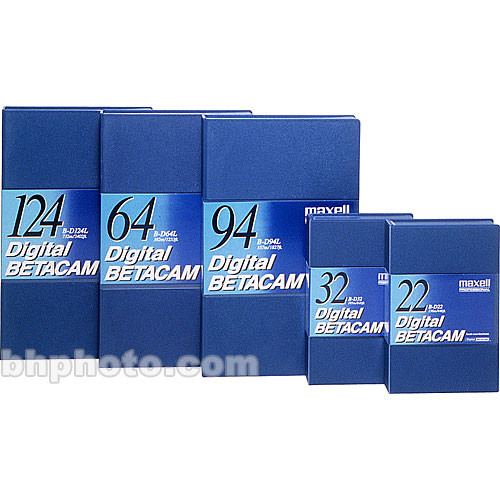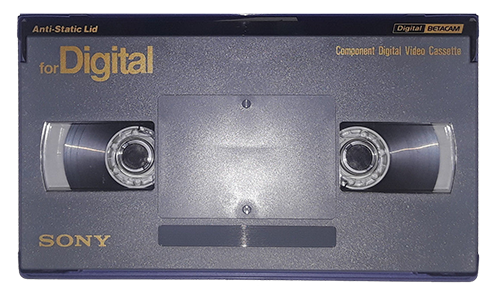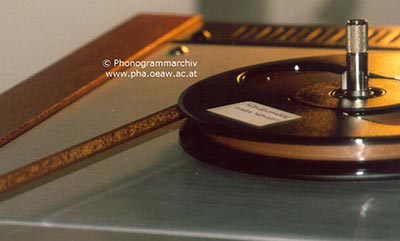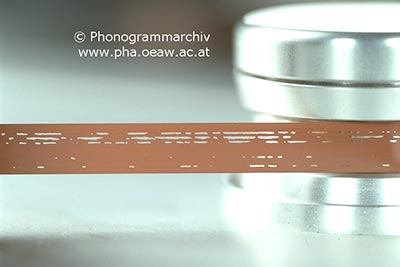| Table of Contents |
|---|
Introduction
...
Digital Betacam decks implemented an SDI coaxial digital connection, which allowed video production facilities to transmit digital signals on existing coaxial wiring without having to commit to rewiring other equipment.
Identification
...
| Info | ||
|---|---|---|
| ||
https://www.bhphotovideo.com/c/product/100667-REG/Maxell_288515_BD_40_40_Minute_Digital_Betacam.htmlMaxell BD-40 40-Minute Digital Betacam Video Cassette in Album Case (Small). B&H Foto & Electronics Corp. Accessed February 22, 2021. |
| Info | ||
|---|---|---|
| ||
Maxell BD-40 40-Minute Digital Betacam Video Cassette in Album Case (Small). B&H Foto & Electronics Corp. Accessed February 22, 2021. |
Physical characteristics
...
| Tape width | 1/2 inch |
|---|---|
| Tape composition | Metal particulate |
| Cassette dimensions | small cassette: 6⅛" × 3¾" × 1" large cassette: 9⅓" × 5⅔" × 1" |
| Container dimensions | Most common containers are the manufacturer's hard plastic snap-closure cases. Small cassette cases: 6¾" x 4⅜" Large cassette cases are 10⅝" x 6⅜" x 1¼" |
| Identifying features | Cassettes are usually labelled "Digital Betacam" in the upper right corner |
| Common manufacturers/brands | Sony |
| Playback | Requires camera or deck manufactured for Digital Betacam format. Some Digital Betcam equipment is backwards-compatible with Betacam and Betacam SP. |
...
| Storage environment: temperature | Ideal: 40–54°F (4.5–12°C) Acceptable: 55–60°F (13–15.5°C) |
|---|---|
| Storage environment: humidity | 30-50% RH |
| Container | Digital Betacam containers should pass the Photographic Activity Test (PAT) as specified ISO Standard 18916:2007
Containers are acceptable if they:
Unacceptable containers must be replaced with clean, inert containers. |
| Orientation of tape in storage | Vertical on its end (like books) |
Types of damage and deterioration
...
Binder deterioration
| Info | ||
|---|---|---|
| ||
"1.1.3. Inspect for damage / Look for chemical deterioration / Binder degradation". In Audio Tape Digitisation Workflow. Accessed February 22, 2021. |
Description
Commonly known as "sticky shed syndrome." Affected records will have a visible gummy or powdery residue on the surface of the tape. This can damage both the recorded material and playback equipment. Back-coated tapes are most affected by this type of deterioration.
...
Baking: Holding the tape at an elevated temperature (45°C to 55°C) for a brief period of time (up to 36 hours) can temporarily remove moisture and allow normal playback for a period of one to two weeks. Tapes should not be rewound before baking.
Drop-out
https://www.musiikkiarkisto.fi/audio/audio113.html
| Info | ||
|---|---|---|
| ||
"1.1.3. Inspect for damage / Look for chemical deterioration / Binder degradation". In Audio Tape Digitisation Workflow. Accessed February 22, 2021. |
Description
A brief signal loss caused by a tape head clog, missing magnetic oxide particles, tape defect, or debris on the tape or machine. These factors can reduce head-to-tape spacing and result in the appearance of white spots or streaks on playback. Multiple drop-outs per frame will result in a snowy appearance.
...
Visit the /wiki/spaces/ALC/overview for further reading on /wiki/spaces/ALC/pages/1891631115.
References
...
AMIA. "Video Preservation Factsheets." Accessed December 10, 2020.
Bensinger, Charles. "Chapter 6: All about videotape." In The Video Guide, Second Edition, 71-75. Santa Barbara, California: Video-Info Publications, 1981.
Bogart, John Van. "What Can Go Wrong With Magnetic Media?" In Magnetic Tape Storage and Handling: A Guide for Libraries and Archives. Washington, DC: The Commission on Preservation and Access, 1995.
Casey, Mike. "FACET: Format characteristics and preservation problems." Bloomington, IN: Indiana University, 2007.
Gibson, Gerald. D. "Magnetic tape deterioration: recognition, recovery and prevention." Paper presented at the IASA Conference, Perugia, August 26, 1996.
Jimenez, Mona and Liss Platt. "Videotape Identification and Assessment Guide." Texas Commission on the Arts, 2004.
Museum of Obsolete Media. Digital Betacam (1993-2016). Accessed February 8, 2021. Wheeler, Jim. "Videotape preservation handbook." 2002.
Preservation Self Assessment Program. "Videotape: Digital Betacam." University of Illinois at Urbana-Champaign. Accessed February 8, 2021.
Version history
...
| Version | Date | Author(s) | Version Notes |
|---|---|---|---|
...



